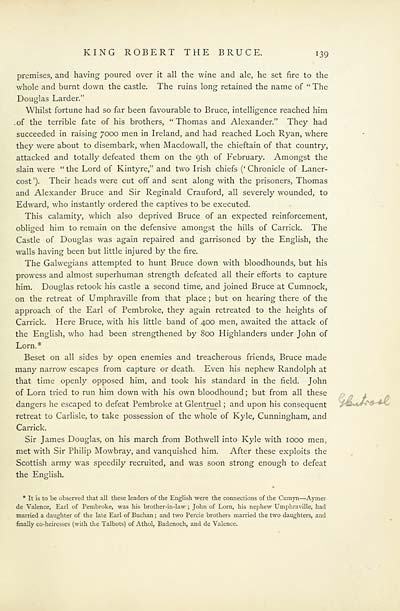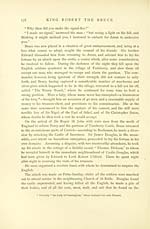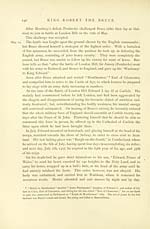Family records of the Bruces and the Cumyns
(151) Page 139
Download files
Complete book:
Individual page:
Thumbnail gallery: Grid view | List view

KING ROBERT THE BRUCE. 139
premises, and having poured over it all the wine and ale, he set fire to the
whole and burnt down the castle. The ruins long retained the name of " The
Douglas Larder."
Whilst fortune had so far been favourable to Bruce, intelligence reached him
of the terrible fate of his brothers, "Thomas and Alexander." They had
succeeded in raising 7000 men in Ireland, and had reached Loch Ryan, where
they were about to disembark, when Macdowall, the chieftain of that country,
attacked and totally defeated them on the 9th of February. Amongst the
slain were "the Lord of Kintyre," and two Irish chiefs ('Chronicle of Laner-
cost '). Their heads were cut off and sent along with the prisoners, Thomas
and Alexander Bruce and Sir Reginald Crauford, all severely wounded, to
Edward, who instantly ordered the captives to be executed.
This calamity, which also deprived Bruce of an expected reinforcement,
obliged him to remain on the defensive amongst the hills of Carrick. The
Castle of Douglas was again repaired and garrisoned by the English, the
walls having been but little injured by the fire.
The Galwegians attempted to hunt Bruce down with bloodhounds, but his
prowess and almost superhuman strength defeated all their efforts to capture
him. Douglas retook his castle a second time, and joined Bruce at Cumnock,
on the retreat of Umphraville from that place ; but on hearing there of the
approach of the Earl of Pembroke, they again retreated to the heights of
Carrick. Here Bruce, with his little band of 400 men, awaited the attack of
the English, who had been strengthened by 800 Highlanders under John of
Lorn.*
Beset on all sides by open enemies and treacherous friends, Bruce made
many narrow escapes from capture or death. Even his nephew Randolph at
that time openly opposed him, and took his standard in the field. John
of Lorn tried to run him down with his own bloodhound ; but from all these
dangers he escaped to defeat Pembroke at Glentruel ; and upon his consequent
retreat to Carlisle, to take possession of the whole of Kyle, Cunningham, and
Carrick.
Sir James Douglas, on his march from Bothwell into Kyle with 1000 men,
met with Sir Philip Mowbray, and vanquished him. After these exploits the
Scottish army was speedily recruited, and was soon strong enough to defeat
the English.
* It is to be observed that all these leaders of the English were the connections of the Cumyn — Aymer
de Valence, Earl of Pembroke, was his brother-in-law ; John of Lorn, his nephew Umphraville, had
married a daughter of the late Earl of Buchan ; and two Percie brothers married the two daughters, and
finally co-heiresses (with the Talbots) of Athol, Badenoch, and de Valence.
§&Jr+*e
premises, and having poured over it all the wine and ale, he set fire to the
whole and burnt down the castle. The ruins long retained the name of " The
Douglas Larder."
Whilst fortune had so far been favourable to Bruce, intelligence reached him
of the terrible fate of his brothers, "Thomas and Alexander." They had
succeeded in raising 7000 men in Ireland, and had reached Loch Ryan, where
they were about to disembark, when Macdowall, the chieftain of that country,
attacked and totally defeated them on the 9th of February. Amongst the
slain were "the Lord of Kintyre," and two Irish chiefs ('Chronicle of Laner-
cost '). Their heads were cut off and sent along with the prisoners, Thomas
and Alexander Bruce and Sir Reginald Crauford, all severely wounded, to
Edward, who instantly ordered the captives to be executed.
This calamity, which also deprived Bruce of an expected reinforcement,
obliged him to remain on the defensive amongst the hills of Carrick. The
Castle of Douglas was again repaired and garrisoned by the English, the
walls having been but little injured by the fire.
The Galwegians attempted to hunt Bruce down with bloodhounds, but his
prowess and almost superhuman strength defeated all their efforts to capture
him. Douglas retook his castle a second time, and joined Bruce at Cumnock,
on the retreat of Umphraville from that place ; but on hearing there of the
approach of the Earl of Pembroke, they again retreated to the heights of
Carrick. Here Bruce, with his little band of 400 men, awaited the attack of
the English, who had been strengthened by 800 Highlanders under John of
Lorn.*
Beset on all sides by open enemies and treacherous friends, Bruce made
many narrow escapes from capture or death. Even his nephew Randolph at
that time openly opposed him, and took his standard in the field. John
of Lorn tried to run him down with his own bloodhound ; but from all these
dangers he escaped to defeat Pembroke at Glentruel ; and upon his consequent
retreat to Carlisle, to take possession of the whole of Kyle, Cunningham, and
Carrick.
Sir James Douglas, on his march from Bothwell into Kyle with 1000 men,
met with Sir Philip Mowbray, and vanquished him. After these exploits the
Scottish army was speedily recruited, and was soon strong enough to defeat
the English.
* It is to be observed that all these leaders of the English were the connections of the Cumyn — Aymer
de Valence, Earl of Pembroke, was his brother-in-law ; John of Lorn, his nephew Umphraville, had
married a daughter of the late Earl of Buchan ; and two Percie brothers married the two daughters, and
finally co-heiresses (with the Talbots) of Athol, Badenoch, and de Valence.
§&Jr+*e
Set display mode to:
![]() Universal Viewer |
Universal Viewer | ![]() Mirador |
Large image | Transcription
Mirador |
Large image | Transcription
Images and transcriptions on this page, including medium image downloads, may be used under the Creative Commons Attribution 4.0 International Licence unless otherwise stated. ![]()
| Histories of Scottish families > Family records of the Bruces and the Cumyns > (151) Page 139 |
|---|
| Permanent URL | https://digital.nls.uk/95072798 |
|---|
| Description | A selection of almost 400 printed items relating to the history of Scottish families, mostly dating from the 19th and early 20th centuries. Includes memoirs, genealogies and clan histories, with a few produced by emigrant families. The earliest family history goes back to AD 916. |
|---|

